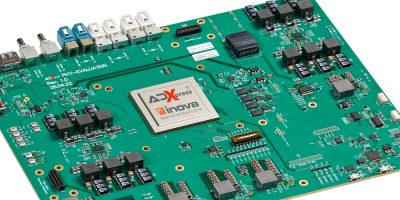ADXpress redefines vehicle connectivity, says Inova Semiconductors
Architecture to enable data transmission in vehicles to a completely new dimension has been presented by Inova Semiconductors. The ADXpress, Automotive Data Express, transmits all raw sensor data via sensor-specific, virtual data paths with deterministic latency to one or more evaluation units. The sensors can be connected to an ADXpress node via PCI Express, Ethernet or SPI, whereby the data transfers are currently carried out electrically with 30Gbits per second or with optical media, with 4 x 24Gbits per second. The data rate is essentially only limited by the physical layer medium and the capability of the technology node.
ADXpress replaces the familiar point-to-point or point-to-repeater concepts with more integrable and flexible topologies, said Inova Semiconductors. This also opens up new possibilities in all aspects of sensor data fusion for advanced driver assistance systems (ADAS) and autonomous driving (AD). The number of displays that can be controlled and maximum resolutions will continue to increase significantly,” said Roland Neumann, CTO of Inova Semiconductor.
The ADXpress technology bundles different data paths on a serial 30Gbits per second data link (already used in APIX, the Automotive Pixel Link from Inova Semiconductors). ADXpress is a universal mass data transport system that electrically transmits any type of data – whether pixel, Ethernet or sensor data from camera, lidar and radar. This opens up new possibilities for network architecture and topologies including new approaches to the implementation of video interfaces, for example via PCI Express.
ADXpress technology is based on virtual data paths, which are realised by transmitting data cells of constant size. All cells take the same path through the network. Unlike IP (Internet Protocol), where a packet can reach its destination via a different path than previous and subsequent packets, ADXpress latency and jitter are constant on a virtual path. Virtual data paths based on data cells have the great advantage that multiplexing, repeating and duplicating can take place on the layer processing the data cells independently of the service. Particularly with multiplexing, it is possible to control or steer the bandwidth allocation and the latency of the individual data paths. The 128 virtual data paths of ADXpress only consume bandwidth when user data is being transmitted
Generic application adaptation units for burst and stream data implemented in hardware enable software-free packaging and de-packaging of continuous (radar, lidar, video) or burst-oriented data (PCI Express, Ethernet, SPI) into a uniform cell format with ADXpress. This allows burst and stream data to be combined with particularly low latency, explained Inova Semiconductors. This, in turn, enables simultaneous bundling of a large number of interfaces across multiple functional units due to the bi-directional structure of ADXpress – in any direction and with any input and output points. These features enable universal network topologies that can be adapted to any conceivable interface.
Inova Semiconductors will present the ADXpress concept at electronica 2022 in Munich (15 to 18 November) at the Inova Semiconductors stand in Hall B4-301.




